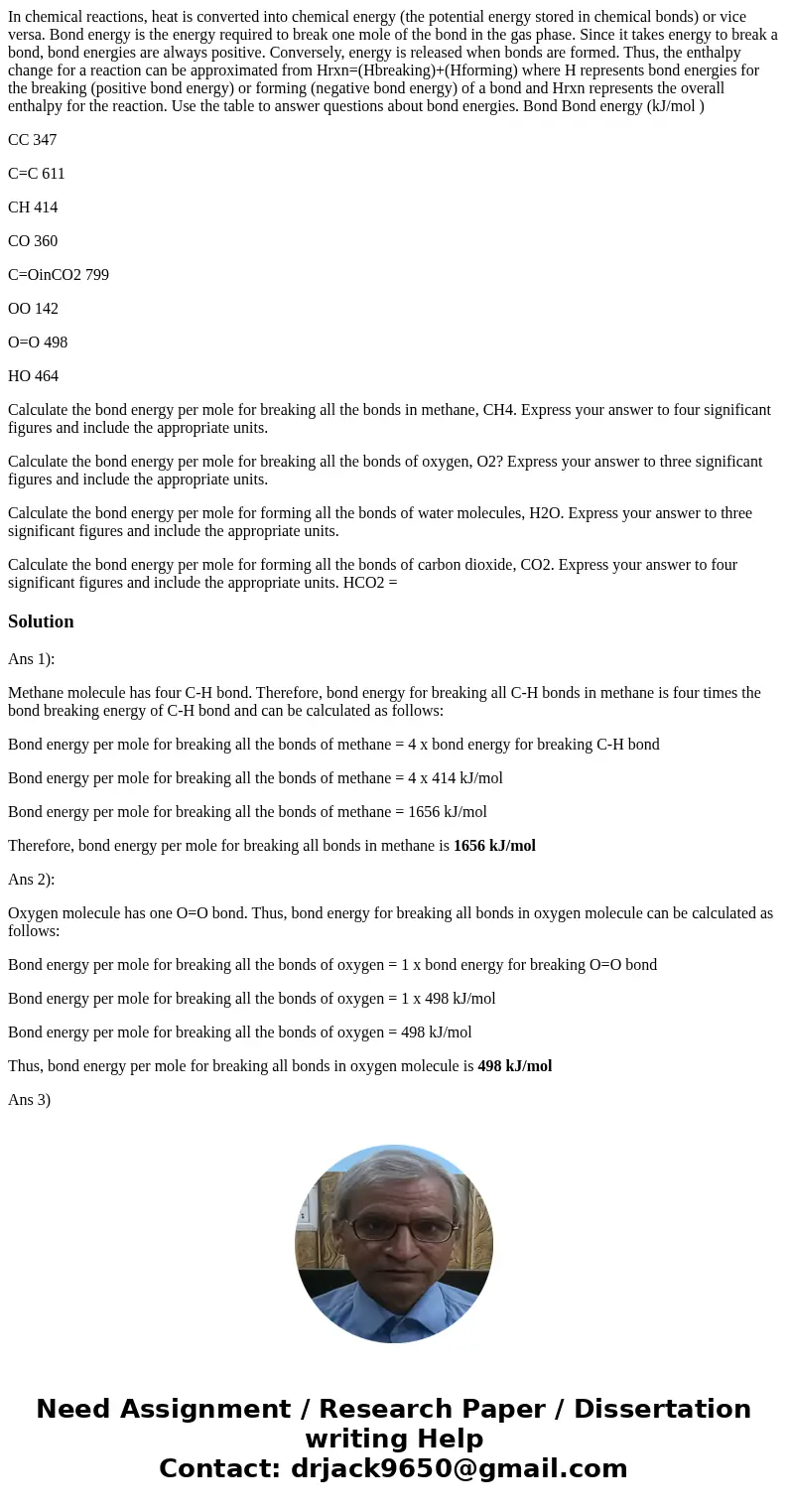In chemical reactions heat is converted into chemical energy
In chemical reactions, heat is converted into chemical energy (the potential energy stored in chemical bonds) or vice versa. Bond energy is the energy required to break one mole of the bond in the gas phase. Since it takes energy to break a bond, bond energies are always positive. Conversely, energy is released when bonds are formed. Thus, the enthalpy change for a reaction can be approximated from Hrxn=(Hbreaking)+(Hforming) where H represents bond energies for the breaking (positive bond energy) or forming (negative bond energy) of a bond and Hrxn represents the overall enthalpy for the reaction. Use the table to answer questions about bond energies. Bond Bond energy (kJ/mol )
CC 347
C=C 611
CH 414
CO 360
C=OinCO2 799
OO 142
O=O 498
HO 464
Calculate the bond energy per mole for breaking all the bonds in methane, CH4. Express your answer to four significant figures and include the appropriate units.
Calculate the bond energy per mole for breaking all the bonds of oxygen, O2? Express your answer to three significant figures and include the appropriate units.
Calculate the bond energy per mole for forming all the bonds of water molecules, H2O. Express your answer to three significant figures and include the appropriate units.
Calculate the bond energy per mole for forming all the bonds of carbon dioxide, CO2. Express your answer to four significant figures and include the appropriate units. HCO2 =
Solution
Ans 1):
Methane molecule has four C-H bond. Therefore, bond energy for breaking all C-H bonds in methane is four times the bond breaking energy of C-H bond and can be calculated as follows:
Bond energy per mole for breaking all the bonds of methane = 4 x bond energy for breaking C-H bond
Bond energy per mole for breaking all the bonds of methane = 4 x 414 kJ/mol
Bond energy per mole for breaking all the bonds of methane = 1656 kJ/mol
Therefore, bond energy per mole for breaking all bonds in methane is 1656 kJ/mol
Ans 2):
Oxygen molecule has one O=O bond. Thus, bond energy for breaking all bonds in oxygen molecule can be calculated as follows:
Bond energy per mole for breaking all the bonds of oxygen = 1 x bond energy for breaking O=O bond
Bond energy per mole for breaking all the bonds of oxygen = 1 x 498 kJ/mol
Bond energy per mole for breaking all the bonds of oxygen = 498 kJ/mol
Thus, bond energy per mole for breaking all bonds in oxygen molecule is 498 kJ/mol
Ans 3)
Water molecule has two O-H bonds. Therefore, bond energy for forming two O-H bonds in water is two times the bond forming energy of O-H bond and can be calculated as follows:
Bond energy per mole for forming all the bonds of water = 2 x bond energy for forming O-H bond
Bond energy per mole for forming all the bonds of water = 2 x (-464 kJ/mol)
Bond energy per mole for forming all the bonds of water =- 928 kJ/mol
Thus, Bond energy per mole for forming all the bonds of water molecule is -928 kJ/mol
Ans 4)
Carbon dioxide molecule has two C=O bonds. Therefore, bond energy for forming two C=O bonds in water is two times the bond forming energy of C=O bond and can be calculated as follows:
Bond energy per mole for forming all the bonds of CO2 = 2 x bond energy for forming C=O bond
Bond energy per mole for forming all the bonds of CO2 = 2 x (-799 kJ/mol)
Bond energy per mole for forming all the bonds of CO2 = -1598 kJ/mol
Thus, Bond energy per mole for forming all the bonds of CO2 molecule is -1598 kJ/mol


 Homework Sourse
Homework Sourse